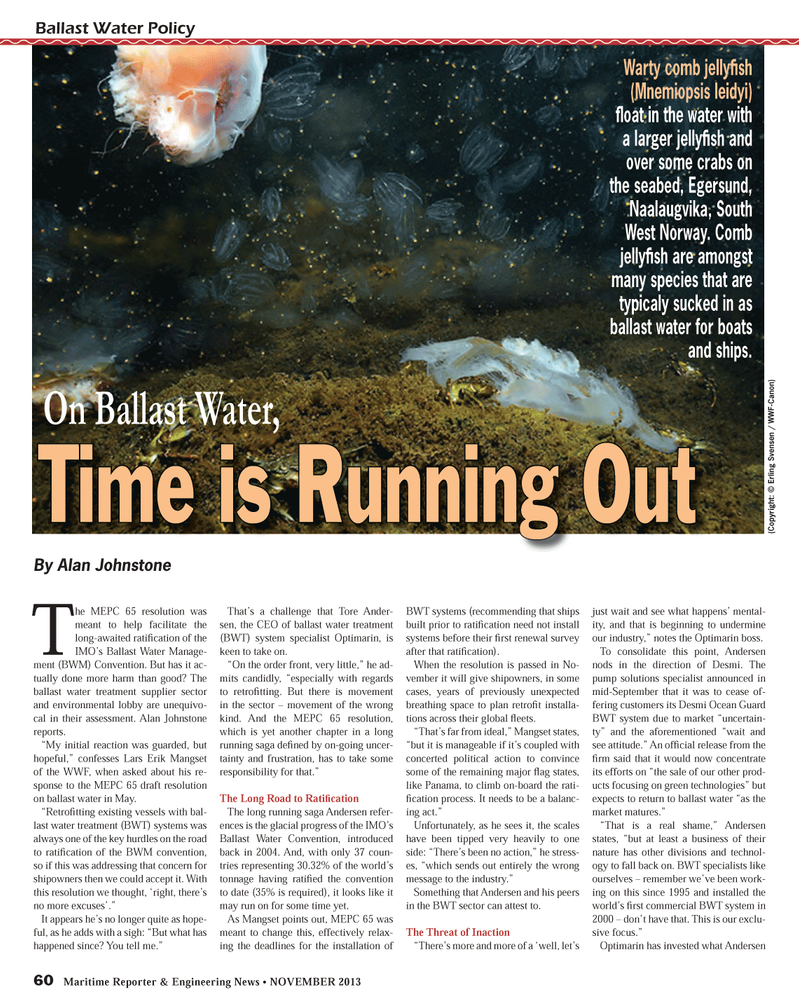
Page 60: of Maritime Reporter Magazine (November 2013)
Marine Propulsion Annual
Read this page in Pdf, Flash or Html5 edition of November 2013 Maritime Reporter Magazine
60 Maritime Reporter & Engineering News ? NOVEMBER 2013 Ballast Water PolicyThe MEPC 65 resolution was meant to help facilitate the long-awaited ratiÞ cation of the IMO?s Ballast Water Manage- ment (BWM) Convention. But has it ac-tually done more harm than good? The ballast water treatment supplier sector and environmental lobby are unequivo-cal in their assessment. Alan Johnstone reports.?My initial reaction was guarded, but hopeful,? confesses Lars Erik Mangset of the WWF, when asked about his re- sponse to the MEPC 65 draft resolution on ballast water in May. ?RetroÞ tting existing vessels with bal-last water treatment (BWT) systems was always one of the key hurdles on the road to ratiÞ cation of the BWM convention, so if this was addressing that concern for shipowners then we could accept it. With this resolution we thought, ?right, there?s no more excuses?.?It appears he?s no longer quite as hope- ful, as he adds with a sigh: ?But what has happened since? You tell me.? That?s a challenge that Tore Ander- sen, the CEO of ballast water treatment (BWT) system specialist Optimarin, is keen to take on.?On the order front, very little,? he ad-mits candidly, ?especially with regards to retroÞ tting. But there is movement in the sector ? movement of the wrong kind. And the MEPC 65 resolution, which is yet another chapter in a long running saga deÞ ned by on-going uncer- tainty and frustration, has to take some responsibility for that.?The Long Road to RatiÞ cationThe long running saga Andersen refer- ences is the glacial progress of the IMO?s Ballast Water Convention, introduced back in 2004. And, with only 37 coun- tries representing 30.32% of the world?s tonnage having ratiÞ ed the convention to date (35% is required), it looks like it may run on for some time yet.As Mangset points out, MEPC 65 was meant to change this, effectively relax- ing the deadlines for the installation of BWT systems (recommending that ships built prior to ratiÞ cation need not install systems before their Þ rst renewal survey after that ratiÞ cation). When the resolution is passed in No-vember it will give shipowners, in some cases, years of previously unexpected breathing space to plan retroÞ t installa- tions across their global ß eets.?That?s far from ideal,? Mangset states, ?but it is manageable if it?s coupled with concerted political action to convince some of the remaining major ß ag states, like Panama, to climb on-board the rati-Þ cation process. It needs to be a balanc-ing act.?Unfortunately, as he sees it, the scales have been tipped very heavily to one side: ?There?s been no action,? he stress- es, ?which sends out entirely the wrong message to the industry.? Something that Andersen and his peers in the BWT sector can attest to. The Threat of Inaction ?There?s more and more of a ?well, let?s just wait and see what happens? mental-ity, and that is beginning to undermine our industry,? notes the Optimarin boss. To consolidate this point, Andersen nods in the direction of Desmi. The pump solutions specialist announced in mid-September that it was to cease of-fering customers its Desmi Ocean Guard BWT system due to market ?uncertain- ty? and the aforementioned ?wait and see attitude.? An of Þ cial release from the Þ rm said that it would now concentrate its efforts on ?the sale of our other prod- ucts focusing on green technologies? but expects to return to ballast water ?as the market matures.??That is a real shame,? Andersen states, ?but at least a business of their nature has other divisions and technol-ogy to fall back on. BWT specialists like ourselves ? remember we?ve been work-ing on this since 1995 and installed the world?s Þ rst commercial BWT system in 2000 ? don?t have that. This is our exclu- sive focus.?Optimarin has invested what Andersen Time is Running Out On Ballast Water, Warty comb jellyÞ sh (Mnemiopsis leidyi) ß oat in the water with a larger jellyÞ sh and over some crabs on the seabed, Egersund, Naalaugvika, South West Norway. Comb jellyÞ sh are amongst many species that are typicaly sucked in as ballast water for boats and ships. By Alan Johnstone(Copyright: © Erling Svensen / WWF-Canon)MR #11 (58-65).indd 60MR #11 (58-65).indd 6011/11/2013 12:15:09 PM11/11/2013 12:15:09 PM

 59
59

 61
61
